

We inject a DynamoDB table for service discovery. “The developer defines a CloudFormation template in YAML. It is made up of one stack per microservice,” explained Kehoe. “We create an application consisting of a set of microservices. To manage serverless at scale, Kehoe uses a range of AWS products, including the AWS IoT platform, the infrastructure-as-code service CloudFormation and the serverless functionality of AWS Lambda.Īcross using these services in combination, iRobot needs to manage audit ability requirements as a global enterprise, which is why, Kehoe said, he needs “Serverless Ops.”That led iRobot’s cloud development team to build software, called Cloudr, to manage its serverless microservices architecture. “We see in the future the majority of our products will be internet connected,” Kehoe said, signaling a move not uncommon for smart appliance manufacturers that are transitioning from being a device company to a connected machine company. The other Roombas and iRobot products are internet connected, most recently with an integration to Alexa, and Kehoe points out there is also a Create robot, which is a “Roomba for hackers.” The newest Roombas are internet connected and come with an app so that consumers can control their iRobot via their smartphone.įor now, Kehoe is focusing on the iRobot Roomba 900 series and encouraging that to be a true Internet of Things product.

Kehoe reports that there are some 15 million iRobot models now in the market being used globally, with only 40 percent of them in the United States. IRobot provides a range of vacuum cleaner robots and has branched out into adjacent robotic products, like mops, gutter-cleaners and the like. Managing a Global Robot Fleet in a Serverless Architecture He will be speaking again at the next Serverlessconf, being held in Austin on April 26-28. This time he will focus on what’s missing from serverless providers.Īt Serverlessconf, Kehoe has now shared several updates on his journey using serverless at iRobot, and while a keen advocate and believer, he is also more than willing to discuss in his Medium blogs what the serverless community needs to focus on next in order to mature the tooling. Kehoe is pretty much all in on serverless, as his talks at previous Serverlessconf events in Brooklyn and London attest. This is the challenge facing Ben Kehoe, cloud Robotics Research Scientist at iRobot. Is serverless mature enough to operate at this scale? And you want to start thinking about how some of your 15 million home robot fleets can start talking with other home automation products or share data to the internet in new ways. You need to be able to identify and send out firmware updates in batches. You need to secure your robots when they connect to the cloud.

The majority of the robot units are in homes outside of the United States. What are the challenges of running serverless at scale? Imagine you are running an international consumer robot company on serverless.


 0 kommentar(er)
0 kommentar(er)
